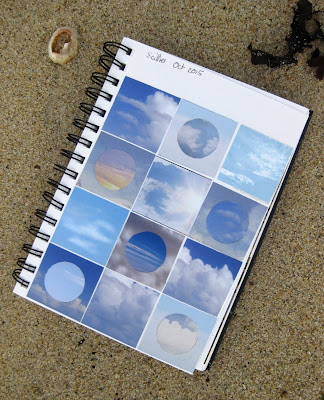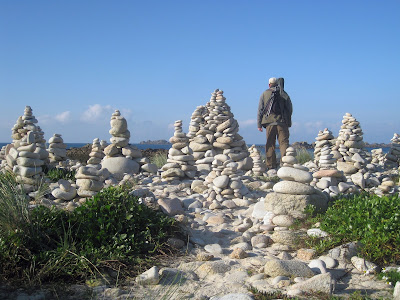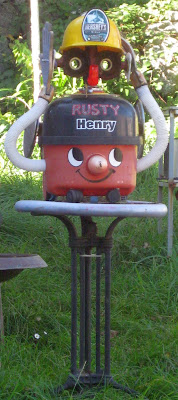 |
Artist at work: Porthloo, St Mary's.
Sign outside Porthloo Studios |
 |
| Anonymous beach installation, Bryher |
How do you create art when you are surrounded by picture-perfect blue skies, turquoise seas, silver beaches, and drifts of running-wild
agapanthus and other semi-tropical flora?
The Isles of Scilly, just 28 miles off the westernmost tip of Cornwall, have a thriving community of artists, so much so that they can claim to be a tourist attraction in their own right, with maps, leaflets and
web pages guiding visitors to their studios and galleries throughout the islands.
 i i |
| Studio in a converted boat shed, Great Par, Bryher |
After all, every visitor to these Fortunate Isles must surely long to tear off a piece of luminous blue sky and bottle some limpid water to take home in their suitcase, and what better way to do so than by buying a work of art made on those very beaches? For the artists, the temptation must be to churn out variations on the theme of blue skies, turquoise seas, silver sand and amethyst amarylis. And who can really blame them; making a living on the islands is notoriously difficult.
Some of the pictures are perfectly pleasing, and I would gladly take home a few - a colourful Tresco piece by
John Dyer would have pride of place - given enough holiday pocket money and wall space. But in my
numerous visits over the years, I have gleefully detected a rather subversive artistic counter-force. I like to think of the resident painters cleaning their brushes at the end of the summer season, flinging aside their uniform smocks, berets and jaunty scarves, and running amok, creating anonymous land art from rocks and pebbles and installations from flotsam, fishing nets and recycled household items. (Rubbish disposal is a big problem on Scilly; so let's make art.)
 |
| Stone sculptures, Bryher and Old Town Bay, St Mary's |
On each visit, I seek out these artworks, seeing what's new, what has been added to, and sometimes what has disappeared entirely. This year I couldn't find my favourite - a "shack" made from all manner of discarded items blown in from the sea and perhaps salvaged from the rubbish dump too: nets, buoys, shells and driftwood, of course, plus an old TV, rubber gloves, plastic chair and lavatory. Perhaps I just went to the wrong Bryher beach - there are so many. Fortunately I have pictures from last time.
New this year were some garden sculptures at Porthlow Farm, St Mary's.
Girls Dancing, said the sign, was made "just for fun" out of unwanted chicken wire, and it was suggested that if the passer-by had enjoyed looking at them they might wish to put a donation in the Cornwall Air Ambulance tin nearby.
 |
| Girls Dancing, Pauline Mawer, Porthlow Farm, St Mary's |
Rusty Henry, in a private garden in Old Town Lane, St Mary's, must surely be just for fun too.
Footnote: I was enormously saddened to find that my friend and favourite maverick artist, who grew up and had spent all her life on St Mary's, suddenly had to leave the islands a month ago for health reasons. It was she who described Scilly as Paradise and said that she never wanted to leave.
After her late father refused to let her study art on the mainland, she taught herself. She could have painted landscapes for tourists but would have none of it ("I would have to stamp them on the front 'A present from Scilly'," she said scathingly). She painted the local hedgerow flowers for postcards (below) and to commission and, with a wicked sense of humour, intricate fantasies of fairies, sorcerers and more sinister creatures. A painting of motorbikes, vampires and gravestones was considered too controversial for the church hall craft fair, but she put it on her stall anyway. She knitted, quilted and embroidered with skill and enormous flair.

Her seafront granite cottage, now being cleared, was a living artwork. Not for her bleached wood, white walls, distressed pale blue and carefully arranged shells. Heavy red velvet curtains, theatrically swagged and braided, hung across the small windows in her tiny living room, with rich red carpet underfoot. The dresser that filled one wall, the numerous small tables, the fireplace and window sills were crammed with an eccentric and eclectic collection of artifacts: table runners, gift shop gewgaws, tourist trinkets, fine coloured glass, "good" china, red silk roses in antique vases, jumble sale finds, and a large stone griffon. The dark red armchairs were draped in velvets, silks, glittery Indian textiles and her own patchwork and applique cushions. On the dark wood paneled walls hung mirrors, her own paintings, her heavily encrusted embroidered flower pictures, and more mirrors. Beads, crystals,glitter balls, Christmas decorations and tassels were strung from the ceiling and looped over door and cupboard handles.
Once she was about to order an ornate chandelier from a catalogue - no small undertaking given that everything has to be brought over from the mainland by boat - when it was pointed out that it was so large it would skim the floor by only a foot and would block her view of the television. To which she responded: "Who needs to watch TV?"
It should have been incredibly kitsch. I suppose it was. But her artist's eye and confidence in her own taste made walking through the door a glorious, jaw-dropping, mind-expanding experience. I always left feeling that anything was possible.
This year I had determined, finally, to ask her if she would allow me to take some photographs. Now it is too late. Scilly will be a sadder and less colourful place without her, but I hope her artistic spirit thrives elsewhere.





































































